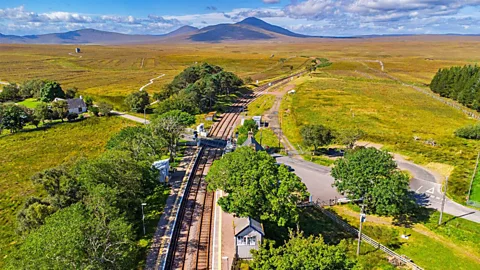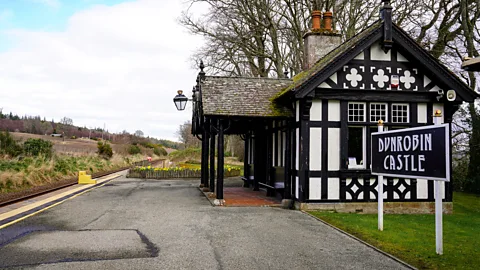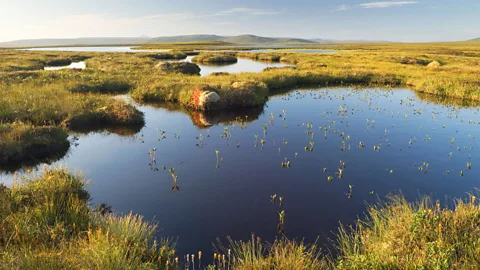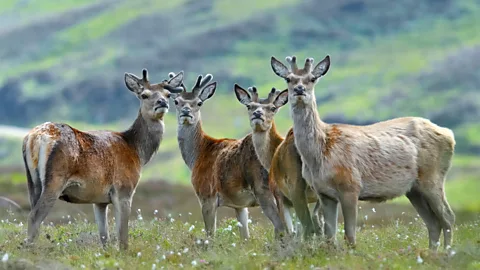Scotland's most remote railway adventure
 Alamy
AlamyRunning from Inverness to Britain's most northerly junction, the Far North Line passes through sheep meadows, traditional villages and the world's only Unesco-listed blanket peat bog.
As the train pulls out of Inverness Station, bound for the utmost reaches of the Scottish Highlands, a familiar thrill tingles through my fingers. Having once called the area home during four summer work seasons, I still feel an unshakable connection to this remote, untamed scenery. And now, at last, I have returned to unite two of my great passions – the romance of rail travel and the peaty moorlands of northern Scotland – in one journey.
It's 07:00 and I'm on the Far North Line that stretches from Inverness to Thurso and Wick at the very tip of mainland Britain. Covering 168 miles and taking around four hours, it's the northernmost railway in Scotland, cutting through the Flow Country; a blanket peat covering much of the northern Highlands. Studded with bog pools and home to a vast array of unique flora and fauna, the Flow Country is the largest and most intact peat system in the world. In 2024, it was named the world's first and only peatland Unesco World Heritage Site. But, for me, the Flow Country's true appeal is its ethereal remoteness.
The sun has blanketed the Highlands for most of my visit, but now, the ground is covered with a dusting of frost that twinkles lightly in the early morning glow. As the train chugs past the village of Conon Bridge and the quaint port town Invergordon, the landscape stays gentle, with hills and farmland rolling past my window. There's no convivial chatter; an early morning start in northern Scotland means people silently clutching their takeaway coffee cups, perhaps preparing mentally for the day ahead. Gazing out of the window, I see a train passing, heading to Inverness. I am going in the opposite direction, deeper into the Highlands, where hurry always seems to fade away.
 Paula Hotti
Paula HottiThe Far North Line was built in stages in the late 19th Century, driven by a more pragmatic goal than my quest for remote landscapes. The tracks were created to boost trade, particularly in fishing and agriculture. The first terminus, Dingwall, opened in 1862, followed by Invergordon the next year. Golspie was reached in 1868, Helmsdale three years later, and finally, Thurso and Wick in 1874.
However, the line's creation was not without its struggles. Harsh weather, tricky terrain and financial difficulties threatened its completion.
Enter the third Duke of Sutherland. A passionate railway enthusiast, the duke had once completed an apprenticeship with the London and North Western Railway to better understand the workings of steam locomotives, writes Michael William in his book, On the Slow Train Again.
The Duke was eager to build a railway that, conveniently, would run close to his doorstep, Dunrobin Castle. On 20 June 1870, an Act of Parliament granted him permission to extend the line from Golspie to Brora and on to Helmsdale. But construction had already begun in anticipation, and by 1 November that year, the Dunrobin-to-Helmsdale section was operational.
 Paula Hotti
Paula HottiToday, Dunrobin Castle Station is one of the Far North Line’s most enchanting stops. Designed in 1902 by L Bisset, its Alpine cottage-like architecture evokes scenes from a Grimm Brothers fairy tale. But on my journey, the train swishes past the station, a humble request stop where passengers press a button should they wish to board.
Soon after Dunrobin, the train reaches the seaside. The 10 miles between Brora and Helmsdale are among the journey's most scenic. I see waves crashing against the shoreline's jagged black stones, sheep grazing on the green fields and a man with two border collies on their morning walk. Then, after Helmsdale, the tracks turn inland, deeper into the Highlands. We are now approaching the Flow Country.
The blanket bog covers 1,544 sq m, about 2.5 times bigger than the metropolitan area of London. When it was inscribed by Unesco, it joined other natural marvels like Australia's Great Barrier Reef and the Galápagos islands on the Unesco list because, as the organisation states, it's "home to a distinct combination of bird species and displays a remarkable diversity of features not found anywhere else on Earth".
Earlier that week, I met with Dr Roxane Andersen, a professor of Peatland Science at the University of the Highlands and Islands, in the village of Lochinver, to discuss the landscape and its recently acquired Unesco status.
Catch the train
Running from Inverness to Thurso and Wick, the Far North Line offers several stops perfect for exploring the area. Trains depart from Inverness four times a day, Monday to Saturday, and once on Sundays. Catch the first train at 07:00, explore, and hop back on the next service departing from Inverness at 10:41, 14:00, and 18:31 – or stay overnight to enjoy the Highlands at a slower pace. Apart from Forsinard and Dunrobin, ideal stops include Tain, home to the historic Glenmorangie whisky distillery just 1.5 miles from the station.
As someone who has been studying the area for more than a decade and was closely involved in securing its World Heritage status, Andersen knows the bogland through and through. It is a land of striking contrasts – hauntingly beautiful, even mysterious at times, stretching from the hills of the west coast to the gentler terrain of the east. Moreover, this vast bogland plays an indispensable ecological role.
"Like all peatlands, the Flow Country plays a critical role in regulating the Earth's climate because it slowly but steadily takes carbon dioxide out of the atmosphere and stores it as dead vegetation, or peat, for millennia. In doing so, it cools the climate," said Andersen.
Along the Far North Line, Forsinard is the best stop to explore this unique landscape. Here, the old train station serves as Forsinard Flows Visitor Centre, open from April to October. From the train station, I stroll the 1 mile Dubh Lochan Trail along a wooden platform to the Flows Lookout Tower, which is open year-round. The platform is dotted with information posts about the landscape, from the trees that used to grow here to the workings of the bog's pool systems.
 Alamy
Alamy"There are places where one can actually walk for tens of kilometres in one direction without seeing another person, without crossing a road," said Graham Thompson, a local resident and tour guide. "It truly is magnificent to still be able to experience this in the UK."
Reaching the wooden two-storey lookout tower, I remember Thompson's words; indeed, there is no one around but relentless wind and an occasional gust of drizzle to keep me company.
I climb the tower and take in the view. The brown peat dotted with dark pools of water extends over the horizon. In its bleakness, the landscape has a strong impact. Here, amidst the bog and water, the creatures that thrive – insects, birds and the occasional mammal such as otters and red deer – form a delicate balance that makes this place truly one of a kind.
 Alamy
Alamy"It is Britain's last remaining wilderness," Thompson told me. And as I stand there, I can feel it.
But the Flow Country is no Paradise Lost. For centuries, it has struggled against the pressures imposed by human actions. On a riverside bench in Lochinver, I listened as Andersen explained how the area was shaped by the aftermath of the Jacobite uprising and the Highland Clearances, when this remote landscape was reshaped into vast estates dedicated primarily to sheep grazing. Once-peopled valleys and straths were emptied, with communities pushed to the coast, leaving behind the bogs and hills.
A more recent struggle dates to the 1980s, when commercial forestry introduced non-native trees and large sections of the bog were drained. While Thompson believes things are getting worse, with wind farms springing up everywhere, Andersen takes a more optimistic view, highlighting the transformation of both the landscape and the people.
"Now all these people sit around the table together and have a shared vision of what could happen in this landscape for the future. And I think that, as a society, the shift from 40 years ago to where we are today in such a short time is truly inspiring."
I leave the viewing tower and Forsinard behind, Andersen's words of hope lingering in my mind, and hop back onto the Far North Line, continuing my journey to the small harbour town of Thurso.
As the train pushes further north, keeping away from the coast, I reflect on the sights I've seen. The Far North Line has delivered most of the typical Scottish imagery, from border collies and sheep to dramatic coastlines and wild bog landscapes. It has been a great alternative to the NC500, a popular and often over-crowded drive around the Highlands, offering a romantic way to experience the wild beauty of the region.
We pass Georgemas Junction, where the line splits towards Thurso and Wick, before finally reaching Thurso, the last train stop before the sea. Along the way, we've passed Beauly Station, home to Scotland's shortest train platform – at just 15.06m long, only one carriage door can be opened for people to exit or enter the train – and we've also passed Altnabreac, the country's most remote station; surrounded by boglands and located 10 miles from the closest road. Georgemas itself is the UK's northernmost junction. But more than these superlatives, this journey has been about slowing down and allowing the mind to wander.
Few rail journeys provide such a deep sense of solitude and reflection – a quiet, uninterrupted passage through some of Britain’s most remote landscapes, hiding multitudes of stories in its peated layers. It truly is, as Andersen put it, a "legacy of past events".
--
If you liked this story, sign up for The Essential List newsletter – a handpicked selection of features, videos and can't-miss news, delivered to your inbox twice a week.
